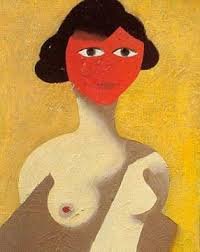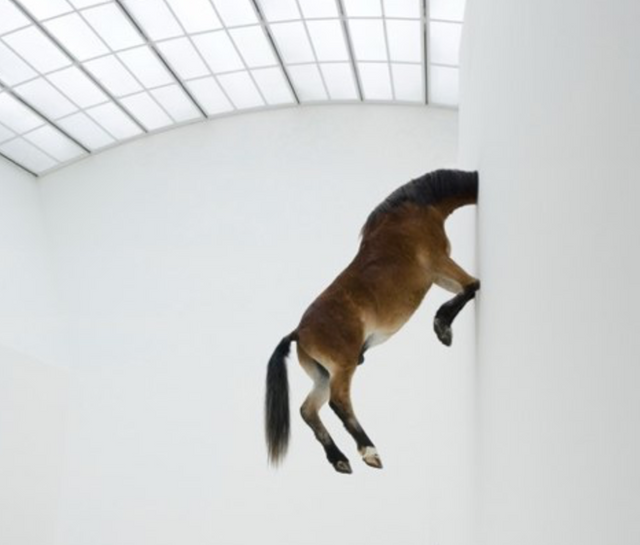Can A Dog Chained to Death be Regarded as "Art"? On the Limits of Artistic Production, The Absurd and the Surreal

“‘Oh, my dear!’ , said Tiresias. Her breasts were getting bigger and bigger and eventually detached from her and flied off like a balloon onto an audience’s bosom.” That was one of the most profound moments of the art of absurdism. In the early 20th century, Guillaume Apollinaire wrote an astonishing drama named “the Breasts of Tiresias”, in which a story is told about a woman whose breasts got bigger and bigger for no reason then finally flied away, causing her become a man. It was shocking for audience who witnessed the emergence of surrealism. While this genius man, Apollinaire, became a leader for his absurdist successors, his extreme approach in classical theatre was censured intensely. There are a few reasons why pop-art absurdists have always been criticised in terms of their “meaning” of art and ethics.

To begin with, the reaction of critics to absurdists’ works were sometimes quite intolerant. Moreover, artlovers were confused, feeling unable to get the message of the so-called surrealist art, actually these artists’ masterpieces were “totally meaningless” for many of them. In fact, surrealist artists were the first pop-art absurdists who gave way to neoteric and marginal trends, still their works were not evaluated as they deserve in real. To be honest, 19th century’s people’s passion and commitment to the ‘classical’ ones lead them to be prejudice against the ‘avant-garde’ ones. To illustrate, Salvador Dali was a ‘crazy aristocrat who is completely lost in his search of eccentric methods in the art of painting’ for most of his contemporaries. In contrast, nowadays his unique works are invaluable and his exhibitions are in demand. To give another example, John Cage, the composer of ‘4′33′′’ could be considered as an absurdist, because this song is an absolute silence for 4′33′′ minutes. In 1952, the premiere of this song was given at Woodstock, New York, by David Tudor who is a popular pianist. He sat on his chair placed near the piano he was supposed to play and opened the keyboard lid. As the minutes pass, people were incapable of stating why he had not started yet. Meanwhile, he closed the keyboard lid and opened it again after a while.. After 4′33′′ minutes, he hailed the audiences and left the stage. Probably, people must have stunned in silence for even more than 4′33′′ minutes with a great bewilderment due to this unexpected experience!

To get beneath the surface, people’s lacking of comprehension of these works basically lays in the main factors. First, people who come face to face with these artworks are generally unable to make a proper connection between the ‘extremely abstract’ and concrete concepts. Indeed, their urge to give concrete meanings to presented artworks contrasts with the aim of artists who rather try to express their own feelings with absurdism. This is why a man who is looking at Marcel Duchapm’s work named ‘Fountain’, which is a photograph of an urinal, itches his head with confusion and snigger. Second, it has always been a debate whether the art should allow people to appreciate its content easier or should be only for its own sake. Nonetheless, it is obvious that some of the works of pop-art absurdism does not make itself more clearer for people who insist on getting explicit messages.

In order to be more precise in the aspect of ethics in popular art absurdism, there are two points to be taken into consideration. The first thing to be taken seriously is the borders of the ‘absurd’ and its extents which can sometimes overstep the limits. Although absurdism is labelled as ‘rubbish’ in many fields by many people, actually absurdism is a phenomena which carried art even beyond the limits of philosophy. Unfortunately, there are examples of pop-art absurdists which can be assertively marked as inhuman rather than philosophical or avant-garde. Guillermo Vargas Habacuc is an artist from Costa Rica who presented a cruel and disgusting pop-art absurdist work in his exhibition. He tied a dog to a wall, giving no food and water for days.

The dog starved and suffered, got weak and eventually faced death. People who come to see the exhibition watched the dog slowly dying. Finally, “the luckiest” of the people who came to see this show witnessed its moment of death. No reaction to this artist could have changed the past and help the poor dog. This was what Habacuc called ‘art’ but for most, this was what is called ‘walking the line’. Then, where is the line? The second point particularly helps us answer this question. The phenomena of art is man-made, so it sustains its existence both with artificiality and reality. Besides, art should be cruel and shocking if needed, as it is so in the photographs of war fields. However, killing a dog can not be considered as neither in the concept of artificiality not reality, it is undoubtedly an action entirely alienated from humanity. These ethical views result in intense criticism of pop-art absurdists.
It seems then, people have commonly been biased against the extreme works of art since a long time. Actually, they can justify this when this is all about ethics, though when it comes to ways of giving meanings and alternative creations of unusual minds, they should open their doors of perception and free themselves from all that is dull and repressive. Art readjusts the reality with certain influences from human nature. However, to be sure to appreciate art’s sense, especially when absurdism is the point, it is needed to be slow to judge.

Thanks for reading! Please comment for a further discussion. I'd love to hear what you think.
Hope he got locked up for the dog cruel bastard
I do hope so.